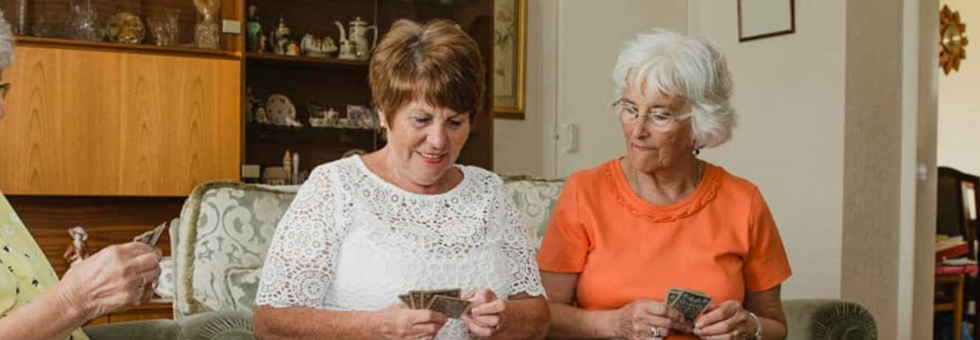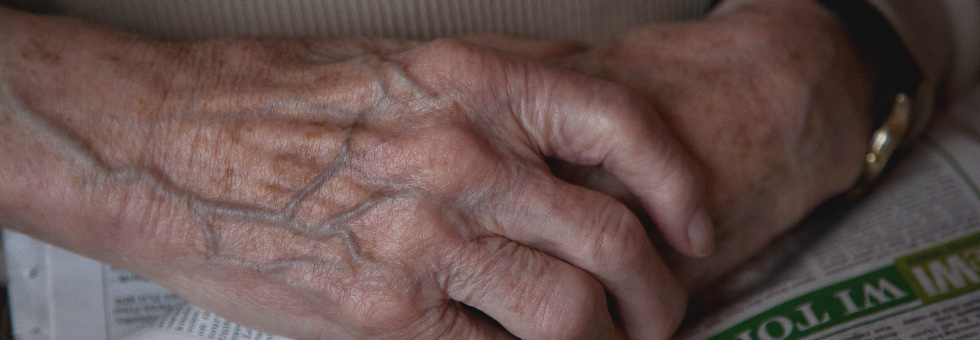Contents
This stage of the case study provides the following information.
- The Personal History sets out what is happening for Don and Madge.
- Values and Ethics – Relating to: Keeping the service user at the centre of practice; Managing different expectations about older people with high support needs; Supervision, critical reflection and analysis
- Law and policy – Relating to: Suicide in later life; Mental health; Mental capacity; Lasting power of attorney
- Knowledge, Evidence and Good Practice – Relating to: Suicide in later life; Anxiety; Depression and complicated grief; Alcohol misuse; Treatment and service efficacy
- Skills – Relating to: Risk assessment; Risk factors; Working with suicide risk; Safeguarding
- Activities – Relating to: Rights, responsibilities and duties; ‘Blocks’ of knowledge; Risk assessment; Challenges
- Additional resources – Relating to: Suicide; Mental health; Reflective supervision; Resilience; Substance misuse
Personal History
After returning home, despite the additional care provided, Don felt abandoned. It was still a struggle for him to communicate and to understand complex communication. He missed Madge terribly and believed that his bereavement, and indeed Madge, had been forgotten since the stroke and, worse still, that he had been forgotten now he was at home. Charlie had looked after Sprocket while Don was in hospital and Don was very pleased to have him home. But he was anxious that he could not look after him properly and that Sprocket would die from Don’s neglect, as Don privately feared Madge had died.
Don’s anxiety was especially bad at night, when his heart raced and he felt panicky and unable to think coherently. Sometimes he could hardly breathe and felt that he was suffocating. He endlessly worried that Sprocket had died and that the boiler needed replacing. Don dreaded trying to organise and pay for a replacement. He started calling his nephew in a state of intense anxiety and found it impossible to communicate with him. Several times Charlie was so concerned that his uncle had had another stroke that he drove through the night only to find Don relatively calm and unharmed. Don also pressed the emergency call button during the night which resulted in two admissions to A and E. Although the medical team recognised that Don’s health was not good, there was no immediate reason to admit him and he was sent home. The Adult Community Care Team were notified of these incidents.
Charlie continued to visit whenever he could but felt useless when Don broke down and cried. He had never seen Don show unconstrained emotion before. Charlie helped with practical tasks, arranged a lasting power of attorney, paid various bills and sorted out Don’s finances, which had got into a muddle. Privately, Charlie felt that the time had come for Don to go into a care home as he was clearly not coping. He wondered how long he too could cope with his uncle’s increasingly unpredictable behaviour and changing needs.
Although the carers were kind and concerned, they assumed that Don was bound to feel sad and depressed after a stroke and that little more could be done to help him. Karen did her best but could only visit Don weekly as her circumstances had changed.
Life for Don was a daily struggle and he was using alcohol to try to calm himself. He was sleeping poorly and was often tearful with helplessness and frustration. Don again wondered if there was any point in living, feeling that he and others would be better off if he was ‘out of it’. He started to actively consider the best way to end his life and knew that he had the means to commit suicide with the equipment in his shed.
Values and Ethics
a) Keeping the service user at the centre of practice
Don’s situation is one of high emotion and stress and there can be little doubt he would benefit from help from services. His complex mix of needs may make it especially challenging to keep him at the centre of practice. There may be some pressure from Charlie – and from Karen – and perhaps the GP in due course to ‘sort Don out’ with haste. One of the few professionals who has an overview of all those involved (family and professionals) and of Don’s intersecting needs is the social worker. Balancing the tensions of a need to act quickly whilst protecting Don’s autonomy and rights to self-determination are pivotal elements of good social work practice with older people (Banks, 2012).
Person centred practice is another skill identified in the Knowledge and Skills Statement for Social Workers in Adult Services. Key elements of this ‘skill’ (as defined by the Statement) relevant to Don’s situation are:
…’meeting the needs and aspirations of the service user in personalised, creative and often novel ways…. working co-productively and innovatively with users, relatives, other professionals, agencies and services to promote self-determination, personal and family reliance, cohesion, earlier intervention and active citizenship. Social workers should also engage with and enable access to advocacy for people who may require help to secure the support and care they need due to physical or mental ill-health, communication impairment, frailty or a combination of these conditions and their physical, psychological and social consequences’ (DH, 2015:3).
Given Don’s complex needs it will be important to prepare well for any meetings with him. This may involve speaking with Don’s GP, Charlie and/or Karen (good practice would suggest asking Don first about speaking with Charlie and Karen) and any other professionals who have worked with Don in the recent past such as hospital staff. Records relating to Don’s recent health or care are another vital source of information (Ray and Phillips, 2012).
b) Managing different expectations about older people with high support needs
There may be conflict about how Don – and others in Don’s environment – view his needs. It is tempting in crisis and when under pressure to compromise the goals of empowerment, co-production and participation when working with a person with high support needs. Charlie may wish Don to be admitted to a care home for ‘his own safety’, Karen may feel the same way but she may also be willing to visit Don more often to maintain his community based life. The GP may consider that Don needs inpatient assessment in a mental health unit but may be willing to refer to an IAPT (Improving Access to Psychological Therapies) service in an effort to make a proportionate decision that disrupts Don’s life to a minimal degree. The social work role here is to take account of these differing perspectives and come to a carefully considered view about Don’s needs.
For more information about older people with high support needs click here:
c) Supervision, critical reflection and analysis
Making proper use of supervision is a key social work skill identified in the Knowledge and Skills Statement for Social Workers in Adult Services (DH, 2015). In thinking through the complexities of Don’s situation especially around risk, suicide and self-neglect, effective use of supervision will be helpful and facilitate better decision making.
Social workers must have access to regular, good quality supervision and understand its importance in providing advice and support. They should know how and when to seek advice from a range of sources including named supervisors, senior social workers and other professionals. They should be able to make effective use of opportunities to discuss, reflect upon and test multiple hypotheses, the role of intuition and logic in decision making, the difference between opinion and fact, the role of evidence, how to address common bias in situations of uncertainty and the reasoning of any conclusions reached and recommendations made, particularly in relation to mental capacity, mental health and safeguarding situations.
Social workers should have a critical understanding of the difference between theory, research, evidence and expertise and the role of professional judgement. They should use practice evidence and research to inform the complex judgements and decisions needed to support, empower and protect their service users. They should apply imagination, creativity and curiosity to working in partnership with individuals and their carers, acknowledging the centrality of people’s own expertise about their experience and needs (DH, 2015:8)
Find out more about the evidence base for effective supervision in social work and social care.
References
Banks, S (2012) 4th edn Ethics and Values in Social Work, Basingstoke: Palgrave Macmillan
Department of Health (DH) (2015) Knowledge and Skills Statement for Social Workers in Adult Services.
Ray, M and Phillips, J. (2012) Social Work with Older People, Basingstoke: Palgrave Macmillan
Law and Policy
a) Suicide in Later Life
Don has become very frail and very frightened. He is lonely and has lost all confidence in being able to manage himself and his life. He sees no future for himself. As he is using alcohol to self-treat his anxiety, is depressed and is actively planning ways to ‘end his life’ he is at risk of suicide.
The report by the Mental Health Task Force for NHS England, Five Year Forward View for Mental Health, calls for a greater focus on suicide prevention (MHT, 2016). Older people and those ‘living with long term physical health conditions’, many of whom are older people, have an increased risk of suicide. They are identified as priority groups for national suicide prevention initiatives in Preventing suicide in England A cross-government outcomes strategy to save lives (HM Government, 2012). No Health Without Mental Health: A Cross-Government Mental Health Outcomes Strategy for People of All Ages (HM Government, 2011) highlighted the importance of routine assessment for depression as part of personalised care planning for people with long-term physical health conditions. These policies recognise that the early identification and prompt, effective treatment of depression has a major role to play in preventing suicide. In 2008 suicide among older people accounted for one in eight of the total number.
References
HM Government (2011) No Health Without Mental Health: A Cross-Government Mental Health Outcomes Strategy for People of All Ages.
HM Government (2012) Preventing suicide in England A cross-government outcomes strategy to save lives.
MHT (2016) Five Year Forward View for Mental Health.
b) Mental Health
The Mental Health Act (1983) is the main piece of legislation that covers the assessment, treatment and rights of people with a mental health disorder. Most people receiving treatment live in the community or, if they are treated in hospital, or another mental health facility, are ‘voluntary patients’ who have agreed to be there (NHS Choices, 2014). Legally it is possible to detain a person (often referred to as ‘sectioning’) who needs assessment and/or urgent treatment for a ‘mental health disorder and are at risk of harm to themselves or others’. Wherever possible a compulsory detention should be avoided and the person supported and treated in the community rather than in hospital (unless there are good reasons for hospital admission).
It is unlikely to be in Don’s best interests for him to be detained in hospital. He is attached to his home and to Sprocket and if his depression is identified and treated appropriately his suicidal ideation may significantly reduce or even disappear. An assessment under s.9 of the Care Act 2014 would also provide an opportunity to investigate mental health issues as mental health is fundamental to wellbeing.
For further information about assessment as required under The Care Act (s.9), see June – July 2017, Law and Policy.
References
NHS Choices (2014) A guide to mental health services in England (including the Mental Health Act).
c) Mental Capacity
Mental capacity legislation and policy may also be relevant but requires careful consideration of the issues given the presumption in favour of capacity which is one of the statutory principles of the Mental Capacity Act (MCA) (2005). Whilst there is no suggestion that Don has cognitive impairment or dementia symptoms, use of alcohol may impair capacity. He has also recently suffered a stroke, has significant communication difficulties, seems challenged by daily activities and is ‘not himself’. His symptoms of depression and anxiety compound these difficulties. The combination of these factors may threaten Don’s capacity to make (some) decisions. Guidance relating to the Mental Capacity Act acknowledges that a lack of mental capacity may be due to a stroke and/or a mental health problem (Social Care Institute for Excellence, 2016).
Whilst an MCA assessment may be helpful an assessment of Don’s mental health is likely to be more appropriate and effective.
A person must be assumed to have capacity unless it is established that he lacks capacity (Mental Capacity Act 2005, s1).
For further information about mental capacity see Sept. 2017 – Nov. 2018, Law and Policy.
Reference
Social Care Institute for Excellence (2016) Mental Capacity Act Resource.
d) Lasting Power of Attorney
Charlie has a lasting power of attorney which permits him to pay various bills and sort out Don’s finances on Don’s behalf.
A Lasting Power of Attorney – LPA – (Age UK) is a way of giving someone you trust the legal authority to make decisions on your behalf if you lack mental capacity at some time in the future or no longer wish to make decisions for yourself. It is a legal document that lets Don (the ‘donor’) appoint Charlie (known as the ‘attorney’) to help him make decisions or to make decisions on his behalf. In order to appoint an ’attorney’, the ‘donor’ i.e. Don, must be aged 18 years or over and have mental capacity – the ability to make your own decisions – at the time of appointment.
There are two types of LPA:
- health and welfare
- property and financial affairs
Charlie only has LPA for Don’s property and financial affairs at the moment. Examples of activities include: managing a bank or building society account; paying bills; collecting benefits or a pension; and/or selling your home. The LPA must be registered with the Office of the Public Guardian before it can be used.
References
Age UK – Lasting Power of Attorney
Office of the Public Guardian – Making a lasting power of attorney.
Knowledge, Evidence and Good Practice
Don is experiencing a number of mental health issues. He is anxious and depressed and is at risk of suicide, all of which indicate that it would be helpful for him to be referred to the local older people’s mental health team as a matter of urgency. Don’s GP needs to be asked to refer him and the GP may also do an assessment first. If Don is unwilling to attend the surgery the GP will need to visit him at home. Don may well benefit from being prescribed anti-depressants and/or being referred for psychological therapy.
The different issues Don is experiencing are looked at separately here.
a) Suicide in later life
It is evident that Don may be planning to commit suicide. He has ‘started to actively consider the best way to end his life and knows that he has the means to commit suicide with the equipment in his shed’. This is a clear signal that urgent intervention is needed.
Evidence suggests that in later life double the number of men as women commit suicide. Men aged over 75 years are particularly at risk. Older people also have a higher risk of ‘successful suicide’ than any other group; major depression is implicated in at least two thirds of cases with untreated and undiagnosed depression a specific risk factor (Ray et al., 2009). Risk factors for suicide mirror those for depression but tend to be more extreme or severe: serious physical illness, pain and multiple long term conditions; loneliness and isolation; and being widowed. Don has lost his main confidante and source of emotional support as well as care. Religious and/or spiritual beliefs and being socially connected appear to be protective factors. As Don has lost touch with the networks he and Madge used to be part of – including the local Methodist church – he has also lost social links and relationships.
See Don and Madge – Background, Law and Policy of this case study to read more about support networks, spirituality and ageing.
b) Anxiety
Don is clearly highly anxious and anxiety symptoms are impacting on his everyday life in a profound way. Anxiety in later life is often linked to depression; this is likely to be the case with Don.
Recent evidence suggests that about 6% of community based older people suffer from a ‘mixed anxiety depressive state’. In terms of treatment options moderate or severe anxiety symptoms are most often managed through a mix of pharmacological and/or psychological treatments. Expert opinion generally advises psychological intervention e.g. cognitive behaviour therapy, or psychosocial intervention. These approaches can be very effective in treating anxiety and depression amongst older people (Byrne, 2013).
Despite their prevalence and the considerable distress they cause, anxiety disorders in older people tend to be both under-diagnosed and under-treated. Much greater effort is needed to make effective treatments routinely available to older people.
c) Depression and complicated grief
Depression is an important but under-recognised aspect of the health of older people. The Mental Health Task Force have reported that ‘one in five older people living in the community and 40 per cent of older people living in care homes are affected by depression’ (MHT, 2016:5). Acute depression is often a response to loss(es). These include health problems and the death of a spouse/partner, both of which are often linked to loss of social activities and opportunities for social engagement as in Don’s case. Chronic depression is a more persistent state. A recent systematic review estimated that 1.6% of all those aged 65 years and over living in the community experience major (clinical) depression, 10% experience minor depression and 30% have depressive symptoms. Stroke is associated with a two or three-fold increase in depression and depression occurs in about a third of people after a stroke (Thomas, 2013).
Symptoms of depression include low mood, sleeplessness, lowered interest in activities, fatigue, weight loss, diminished ability to think or concentrate and feelings of worthlessness (Royal College of Psychiatrists, 2014). Don is experiencing most of these symptoms.
Most depression is managed in primary care with only 6% of older people with depression receiving specialist mental health care. Barriers to diagnosing depression in primary care have been identified as:
- ageism – age related decline in mental well-being being viewed as ‘normal’;
- reluctance on the part of older people especially men to talk about depressive symptoms;
- GPs and other health professionals lacking the skills to diagnose depression in older patients;
- short consultation times with primary care professionals;
- limited access to psychological therapies; and
- ‘system complexity’ for example secondary mental health services being located a long way away from primary care services
(Royal College of GPs and Royal College of Psychiatrists, 2011).
It may be that Don is experiencing what is called ‘complicated grief’ linked to Madge’s death. This is defined as grief which lasts for a longer period, is intense and is associated with severe depressive symptoms.
There is considerable overlap between the symptoms of depression and complicated grief. In grief, thoughts of death or dying are generally focused on the deceased and possibly about joining them. Bereaved people who are also suffering from depression may feel undeserving of life, unable to cope with seemingly unending depression and/or mistakenly believe that others would be better off without them so their thoughts focus more on ending their life. This is evidently the case with Don.
Don needs a careful nuanced assessment of his mental health, taking into account his complicated grief, social situation, history, and environment.
‘I always do think that when elderly people are on their own, whether or note they are acutely ill, whether or not they’ve been bereaved recently, that the carers might go for a brief time three or four times a day but there are still an awful lot of hours in the 24 where that person is on his or her own.’ (Heather)
- It has been estimated that between 10% and 20% of older people suffer ‘complicated grief’, most often linked to the death of a spouse. Complicated grief occurs when something interferes with the process of learning to adapt that is core to healing.
- The result is a situation in which the bereaved person seems ‘stuck’ in acute grief, trying to deal with the complications that block acceptance and adaptation to the loss.
- Complicated grief can be a disabling problem. It is best understood as a severe and persistent form of grief, similar in many respects to the experience almost everyone has when a loved one dies.
d) Alcohol misuse
Don appears to be using alcohol to self-medicate his anxiety and depression. There has been a steady increase in the amount of alcohol consumed by older age groups in recent years. Currently an estimated 1.4 million people aged 65 and over exceed recommended drinking limits; 3% of men and 0.6% of women aged 65-74 are alcohol dependent (Wadd et al., 2011). For some alcohol consumption is associated with ‘self-medication’ of depression, anxiety disorders and loneliness – as appears to be the case with Don. Older people are more susceptible to alcohol related health problems than younger adults and are also more prone to falls. Although alcohol related problems are significantly under-detected in the older populations there is no evidence that they are any less amenable to treatment than they would be in younger populations.
To find out more about alcohol and older people and for a list of support organisations, visit the Royal College of Psychiatrists’ pages on Alcohol and older people.
e) Treatment and service efficacy
There is evidence that older people are denied access to the full range of mental health services that are available to younger adults, including psychological therapies and alcohol services. Although evidence about treatment efficacy is mixed there is little to suggest that treatments for depression are any less effective amongst older people than they are amongst younger adults. What is known is that only about a quarter of all community based older people with depression consult their GP and under a fifth receive treatment.
- In a 500 bed general hospital, on an average day, 330 beds will be occupied by older people of whom 220 will have a mental disorder, 100 each will have dementia and depression and 66 will have delirium.
- For every 1,000 people over the age of 65, 250 will have a mental illness, 135 will have depression, of which 115 will have no treatment.
- 85% of older people with depression receive no help from the NHS, and older people are a fifth as likely as younger age groups to have access to talking therapies but six times as likely to be on medication.
- The number of older people being treated in the improving access to psychological therapies (IAPT) programme rose from 4% to 6.5% (2008/9-2013/14), still short of the articulated goal.
- While 50% of younger people with depression are referred to mental health services, only 6% of older people are.
- Around 10% of older people experience loneliness which can be a symptom course of depression – loneliness has the same health effects as smoking 15 cigarettes a day.
- 20% of men and 10% of women are drinking alcohol in harmful amounts – the latter is a 100% increase over the past twenty years
Evidence suggests that interventions to address suicide are more beneficial to women of all ages. Older men tend to be less inclined to seek medical advice and may have difficulty assessing and recognising their emotions. Risk assessment for suicide could be improved by addressing a wide range of issues frequently faced by suicidal older men, such as pain, dependency, sleep problems, bereavement, and alcohol abuse. Suicide prevention programmes need to address substance misuse in older men, but more research is needed to determine the types of intervention that might be effective in preventing suicide in older men (Lapierre, et al, 2011).
References
Byrne, G (2013) Anxiety disorders in older people, in T. Dening and A. Thomas (Eds) The Oxford Textbook of Old Age Psychiatry, Oxford University Press, p589-602
Lapierre, S., Erlangsen, A., Waern, M., De Leo, D., Oyama, H., Scocco, P., Gallo, J., et al (?) Szanto, K., Conwell, Y., Draper, B., Quinnett, P and the International Research Group for Suicide among the Elderly, (2011) A Systematic Review of Elderly Suicide Prevention Programs, Crisis, 33(2): 88-98
MHT (2016) Five Year Forward View for Mental Health.
Ray, M., Bernard, M and Phillips, J. (2009) Critical Issues in Social Work with Older People, Basingstoke: Palgrave Macmillan
Royal College of GPs and Royal College of Psychiatrists (2011) Management of depression in older people: why this is important in primary care
Royal College of Psychiatrists Alcohol and Older People
Royal College of Psychiatrists (2014) Depression in Older Adults
Thomas, A (2013) Depression in Older People, in T. Dening and A. Thomas (Eds) The Oxford Textbook of Old Age Psychiatry, Oxford University Press, p545-569
Wadd, S., Lapworth K., Sullivan, M.P., Forrester, D., and Galvani S. (2011) Working with Older Drinkers. London: Alcohol Research UK
(f) Implications of complex interaction
Don is located on the intersection of a number of complex issues. He has a serious illness, he is experiencing complicated grief related to Madge’s death, is depressed and anxious and drinking to manage these complex feelings. He is also struggling to manage activities of daily living. It is likely that Don is frightened and lonely and, uncomfortable about acknowledging these feelings, does not know where to turn.
Social work has a tradition of working with complexity – older people who come to the attention of social workers tend to have multiple needs and old age is a stage of life when many people experience multiple losses. Helping older people to manage loss and bereavement, rebuilding confidence and self-esteem, and working with informal and formal care networks are key social work skills (Milne et al, 2014). Transition from one environment to another, such as hospital admission and discharge in Don’s case, is another dimension of complexity (Ray et al, 2015).
- Early UK work – conducted in the late 1970’s and 1980’s – found that specialist social work with older people had the capacity to improve older client’s morale and impact positively on psychological well-being (e.g. Goldberg & Connolly, 1982). Specifically, it can alleviate the symptoms associated with conditions such as depression and impact was greatest in contexts where interventions were well resourced. Research also identifies that social workers based in health care settings such as hospitals, are well placed to respond to the needs of older people (Shah et al., 2001).
- It is also important to reflect on evidence about ‘what matters’ to older service users. The importance of relationship centred social work is highlighted by people with high support needs who use social work services (e.g. Beresford, al., 2008). Evidence from ‘The National User Network’ suggests that the following social work roles and skills are particularly valued by older service users: advice and advocacy; negotiating with providers; psychotherapeutic support; and practical guidance.
- Research also highlights the value older people place on “… social workers’ knowledge about specialist services, persistence, commitment, reliability, and being supportive, sympathetic, and prepared to listen” (Manthorpe et al., 2007: 1142). The relationship an older person has with their social worker is identified as pivotal in underpinning personalised assessment. Evidence suggests that, ’… where due weight is not given to the older person’s perspective in assessments the risk of inappropriate or unwelcome intervention is considerably greater’; it is also more likely to result in an unsustainable package of care (Richards, 2000: 47).
- A recent scoping review The effectiveness of social work with adults provides a valuable insight into the current research and evidence base for social work with older people (Moriarty and Manthorpe (2016).
References
Beresford, P. and Croft, S. Adshead, L. (2008) ‘We don’t see her as a social worker’: a service user case study of the importance of the social worker’s relationship and humanity, The British Journal of Social Work, 38(7):1388-1407.
Goldberg, E.M. and Connolly, N. (1982) The Effectiveness of Social Care for the Elderly. London: Heinnemann
Manthorpe, J., Moriarty, J. Rapaport, J. Clough R. Cornes, M. Bright, L. Illiffe, S. and OPRSI (2007) ‘There are Wonderful Social Workers but It’s a Lottery”: Older People’s views about Social Workers’ British Journal of Social Work, 38:1132-50.
Milne, A., Sullivan, M.P., Tanner, D., Richards, S., Ray, M., Lloyd, L., Beech, C and Phillips, J (2014) Social Work with Older People: A Vision for the Future, The College of Social Work, London
Moriarty, J. and Manthorpe, J. (2016) The effectiveness of social work with adults: A systematic scoping review
Ray, M., Milne, A., Beech, C., Phillips, J., Richards, S., Sullivan, M.P., Tanner, D., and Lloyd, L (2015) Gerontological Social Work: Reflections on its Role, Purpose and Value, British Journal of Social Work 45(4):1296-1312
Richards, S. (2000) Bridging the Divide: Elders and the Assessment Process, British Journal of Social Work 30(1):37-49
Shah, A., Wuntakal, B., Fehler, J and Sullivan, P (2001) Is a dedicated specialist social worker working exclusively with psychogeriatric inpatients and an associated dedicated domiciliary care package cost-effective? International Psychogeriatrics, 13(3) 337-346.
Skills
Don’s situation is not only complex but he is vulnerable and at risk of suicide. Risk assessment is a key skill required in this context.
a) Risk Assessment
Risk assessment is a significant component of assessments with many of the adults seen by social workers. Older adults may become vulnerable and live at risk because of any combination of cognitive, psychosocial and/or physical health problems. The aim of risk assessment is to consider a situation, event or decision and identify where risks fall on the dimensions of ‘likely or unlikely’ and ‘harmful or beneficial’. Social workers are expected to balance rights and responsibilities in relation to risk, regularly re-assess risk, recognise risk to self and colleagues and work within the risk assessment procedures of their own and other organisations and professions.Key principles underpinning risk assessment practice are to:
- Help people to have choice and control over their lives
- Recognise that making a choice can involve some risk: this is part of life
- Respect people’s rights and autonomy and the rights of family carers
- Help people understand their responsibilities and the implications of their choices, including any risk
Most models of risk assessment recognise that it is not possible to eliminate risk, despite the pressure on public authorities to adopt defensive risk management. Research findings about the nature and dimensions of risk assessment models used by health and social care practitioners indicate that professionals rely heavily upon their work experience and informal learning from colleagues to guide their professional judgements rather than explicit (or even implicit) use of theoretical models or research related knowledge (Skills for Care, 2011).
- A review by Taylor (2006) identifies six paradigms that underpin decision-making in relationship to risk:
- Identifying and meeting needs: people come with needs, and the professional task is to assess these in relation to circumstances and meet them where possible.
- Minimising situational hazards: helping service users and staff (particularly home care workers) to avoid domestic hazards, with an emphasis upon avoiding risk rather than taking risk.
- Protecting this individual and others: in situations where individuals may harm others or themselves, their wishes may have to be challenged and a decision imposed without consent.
- Balancing benefits and harms: risk-taking (as opposed to only risk avoidance) is seen as an intrinsic part of the job and sometimes necessary to encourage rehabilitation.
- Accounting for resources and priorities: resource shortage results in the establishment of ‘panels’ to ensure justifiable resource allocation that is prioritised by conceptually labelling levels of risk that relate to the urgency of the response required.
- Wariness of lurking conflicts: staff concerns of being at risk themselves, such as concern at being sued or becoming the focus of unwanted media attention – a ‘sixth sense’ of professional danger.
Taylor concludes that ‘no single model for doing risk emerged’ – rather there are distinct conceptual frameworks that are used as required, with professionals moving between the six paradigms he identifies. The underpinning rationale was more about what was defensible rather than what was right – fear of taking risks led to the avoidance of more positive approaches to promoting health and wellbeing.
- Richards and colleagues (2007) similarly conclude, from analysis of professional responses to a case scenario involving risk, that the most prominent professional understanding of old age is based on experience (rather than theory or evidence) and is largely derived from working with older people in difficulty. The authors suggest that this leads to a negative perception of old age as a problematic life stage, a perception at odds with the policy emphasis on active ageing, prevention, choice and informed risk taking. Although knowledge based on experience is regarded as an essential component of good practice, Richards et al (2007) argue that theoretical and research-based knowledge can support and promote the development of sensitive and reflective practice that does not limit the potential of older people to take informed risks that enhance their quality of life.
- A critical gerontological social work approach would widen the risk agenda to take account of the potential impact of life course inequalities, health inequalities in older age, the social model of disability and the impact of age based discrimination and other forms of exclusion. In other words risk as a concept is bound up with how we view older people and their value in UK society (Ray et al, 2009).
Risk factors
Evidence suggests that both internal and external factors can contribute to vulnerability and risk of adverse outcomes or injury.
Internal risk factors include:
- Increasing age
- Female gender
- Medical co-morbidities
- Substance abuse
- Mental illness
- Cognitive impairment
- Sensory impairment
- Impairment in activities of daily living (ADL)
- Malnutrition
External risk factors include:
- Lack of social network
- Dependence on a care provider
- Living alone
- Lack of community resources
- Inadequate housing
- Unsanitary living conditions
- High-crime neighbourhood
- Adverse life events
- Poverty
Culo (2013)
Worry about risk and danger tend to permeate assessment work with older people. A ‘professional’ desire to reduce risk may act as a barrier to enabling service users to do what they want. The promotion of a person-centred approach aims to maximise independence and minimise risk, and often involves identifying – and helping to address – risks in partnership with the older person. An essential component of risk assessment includes an examination of an individual’s strengths, resources, and willingness to accept intervention. Social workers must weigh all these factors in coming to a view (DH, 2015).
Don could be considered at risk as a consequence of the intersection of: medical co-morbidities, depression and anxiety (as yet undiagnosed and untreated), impairment in activities of daily living, lack of social network, living alone, and complicated grief. His eating habits are also poor and he has trouble sleeping. He may even be considered to be self-neglecting (see safeguarding below). Critical reflection in situations of risk is especially important as the ‘default position’ of most health and social care practitioners is one of risk avoidance and over protection.
References
Culo, S. (2011) Risk assessment and intervention for vulnerable older adults, BC Medical Journal, 53(8):421-425.
Department of Health (DH) (2015) Knowledge and Skills Statement for Social Workers in Adult Services.
Taylor, B (2006) Risk Management Paradigms in Health and Social Services for Professional Decision Making on the Long-Term Care of Older People, British Journal of Social Work, 36 (8):1411-1429
Ray, M., Bernard, M and Phillips, J. (2009) Critical Issues in Social Work with Older People, Basingstoke: Palgrave Macmillan
Richards, S., Donovan, S., Victor, C and Ross, F (2007) Standing Secure Amidst a Falling World? Practitioner Understandings of Old Age in Responses to a Case Vignette, Journal of Inter-professional Care 21(3):335-349
Skills for Care (2011) Learning to Live with Risk.
b) Working with Suicide Risk
Whilst the causes of suicide in older people are complex, there is very strong evidence that depression is a major factor (see Button 2). One way of understanding the relationship between depression and suicide is by seeing feelings of hopelessness and suicidal thoughts as existing along a continuum.
1. Feeling of hopelessness and despair
2. Thoughts that life is not work living
3. Passive wish to die
4. Suicidal ideation
5. Suicide plans
6. Suicide attempts
7. Completed suicide

Talking to an older person who may be depressed is a critical part of assessing their risk of suicide. Giving someone the opportunity to talk about their feelings of despair and hopelessness is often the first step towards offering the support they need and thereby ultimately preventing an act such as suicide (Chiu and Tsoh, 2013). Don is probably at number 5 on the continuum as he has made tentative plans to commit suicide. In terms of effective steps that can be taken to improve the situation, Don needs to be seen by his GP as a matter of urgency with the aim of referring him to the local older people’s mental health team. As Don is an adult with agency and autonomy, it is also essential to keep in mind the balance between reducing risk and maintaining his independence (Ray et al, 2015).
Don displays some of the symptoms of complicated grief. He is caught up in rumination focused on counterfactual accounts of Madge’s death. He believes that he cannot look after Sprocket properly and he may die from Don’s neglect, as Don ‘privately feared Madge had died’. Don may need help to acknowledge his feelings and accept help (including medication) (O’Connell et al, 2004). NICHE guidelines suggest that Don is in an at risk group and should be encouraged to seek and get help for his depression, complicated grief and suicidal ideation (NIHCE, 2009, 2009a). It is important to ensure that any assessment of need does not focus only on the recent events in Don’s life, but recognises his symptoms and problems as situated in a life course and context and that help and responses beyond the bio-medical are explored (Ray et al, 2009).
References
Chiu, H and Tsoh, J. (2013) Suicide and attempted suicide in older people, in T. Dening and A. Thomas (Eds) The Oxford Textbook of Old Age Psychiatry, Oxford University Press, p545-569
NIHCE (2009) Depression in adults: recognition and management, NICE guidelines [CG90]
NIHCE (2009a) Depression in adults with chronic physical health problem: recognition and management, NICE guidelines [CG91]
O’Connell, H., Chin, A-V., Cunningham, C. and Lawlor, B.A. (2004) Recent developments: suicide in older people, British Medical Journal, 329:895-899
Ray, M., Bernard, M and Phillips, J. (2009) Critical Issues in Social Work with Older People, Basingstoke: Palgrave Macmillan
Ray, M., Milne, A., Beech, C., Phillips, J., Richards, S., Sullivan, M.P., Tanner, D., and Lloyd, L (2015) Gerontological Social Work: Reflections on its Role, Purpose and Value, British Journal of Social Work 45(4):1296-1312
c) Safeguarding
Working with abuse and neglect (safeguarding), including self-neglect, is one of the skills identified in the Knowledge and Skills Statements for Social Workers in Adult Services:
‘Social workers must be able to recognise the risk indicators of different forms of abuse and neglect and their impact on individuals, their families or their support networks and should prioritise the protection of children and adults in vulnerable situations whenever necessary. This includes working with those who self-neglect’ (DH, 2015:4).
The Care Act (2014) introduced a legal duty on local authorities and other parts of the health and social care system to protect adults at risk of abuse or neglect. Self-neglect is included as a form of ‘abuse’ and defined in the Care Act statutory guidance:
Self neglect ‘covers a wide range of behaviour neglecting to care for one’s personal hygiene, health or surroundings and includes behaviour such as hoarding. An assessment should be made on a case by case basis. A decision on whether a response is required under safeguarding will depend on the adult’s ability to protect themselves by controlling their own behaviour. There may come a point when they are no longer able to do this, without external support’ (DH, 2016:14.17).
Social workers who work with adults must take an outcomes-focused, person-centred approach to safeguarding practice, recognising that people are experts in their own lives and working alongside them to identify person centred solutions to risk and harm.
Six key principles underpin all adult safeguarding work:
- Empowerment – Personalisation and the presumption of person-led decisions and informed consent.
- Prevention – it is better to take action before harm occurs.
- Proportionality – Proportionate and least intrusive response appropriate to the risk presented.
- Protection – Support and representation for those in greatest need.
- Partnership – local solutions through services working with their communities.
- Accountability – Accountability and transparency in delivering safeguarding. (DH, 2016: 14.13)
A thorough relationship based time rich assessment of Don’s needs and mental health should help to establish whether he is self-neglecting or not. It will be important to carefully and sensitively explore with Don how well he is eating, washing, and looking after himself and it may be helpful to speak to Karen too regarding her views about Don’s personal hygiene and self-care. While (local authority) procedures provide an overall framework for action, ambiguous situations require the exercise of professional judgement.
- The Social Care Institute for Excellence has developed a range of useful resources relating to the Care Act (2014) and safeguarding duties and practice: http://www.scie.org.uk/care-act-2014/safeguarding-adults/
- Also relating specifically to self-neglect
References
Department of Health (DH) (2015) Knowledge and Skills Statement for Social Workers in Adult Services
Department of Health (2016) Care and Support: Statutory Guidance Issued under the Care Act 2014 (Chapter 14: Safeguarding).
Activities
Rights, responsibilities and duties
Thinking about a person’s right to make their own decisions and choices consider Don’s ‘right’ to choose to commit suicide.
- Does anyone have the right to take their own life and in what circumstances can you invoke the law to prevent that outcome?
- Which specific pieces of legislation and policy may help you support Don to have time and opportunity to reconsider and re-evaluate his life and options?
- How might you include Don in balancing rights, responsibilities and duties?
- How might you include Charlie and in what circumstances might consulting with him be a legal requirement?
- What role do other professionals and workers have in supporting Don at this difficult time? How might you work with them effectively to support Don in the short term? In the medium term?
Useful links
Suicide prevention strategies amongst older people – literature review
Promoting Good Practice in Suicide Prevention, a resource published by the Australian Government’s Department of Health and Ageing focuses on activities targeting men
‘Blocks’ of knowledge
Give that Don’s needs are complex think about how the ‘blocks’ of knowledge identified above intersect. Which issues tend to dominate your thinking and why?
Thinking about how little we know about older men and suicide, how might the knowledge generated in your work with Don be used to help other social work practitioners and to advance our understanding of this group of service users?
- What types of resources may be useful in supporting Don? Thinking about Don’s past life which resources might you explore reconnecting Don with?
- Thinking about the area you work in what community, health and social care services are there that a) an older man like Don would find acceptable and b) could be effective in supporting him over the medium or longer term?
Risk assessment
In completing a risk assessment how do you balance Don’s rights as an individual to make ‘unwise decisions’ with the duty of your agency and profession to protect Don from harm including self-neglect and suicide? How might you work with Don to uphold autonomy and self-determination, explore risk and ensure that you pay sufficient attention to issues of safeguarding?
Consider the range and types of skills you will need to employ in conducting a thorough risk assessment of someone in Don’s situation. What do you think you need to do first?
Useful links
Department of Health (2007) Independence, Choice and Risk: a Guide to Best Practice in Supported Decision-making
Skills for Care (2011) Learning to Live with Risk.
Suicide risk assessment pocket card (US resource)
Challenges
Consider the challenges in keeping Don at the centre of practice when faced with the complexity of issues and high levels of emotion. In your experience what helps to ensure that this happens when you are under pressure to ‘act’ and ‘act quickly’ to ‘do something’?
What might be some of the challenges you will face in carefully working with Don and perhaps not ‘acting’ in ways others may wish you to? How might you ensure you look after both Don’s needs and your own in a stressful context like this one? Who may help you think things through and come to clear well considered decisions?
Additional Resources
Don is a white male, but there is evidence that suicide rates are higher in older people from some BME groups. This article reviews the current state of knowledge and highlights gaps in research.
A North American perspective on older women living with anxiety and depression
Overview of mental health statistics for older people in the UK
Reflective supervision in practice (blog article)
Developing social worker’s practice, including the use of professional, reflective supervision – report from Skills For Care
Additional resources added in 2019:
- Improving acute psychiatric care for older people.
- Resilience in ageing.
- Risk of loneliness.
- Substance misuse in older age.
- Addressing ageism in alcohol policy.












